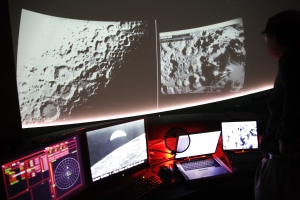It's official: NASA's LCROSS mission found water on the Moon, no bones about it. Though NASA is still analyzing all the data they reaped from the LCROSS impact event on October 9th, and will be for a long time to come, they seem confident enough about the preliminary findings to make this a definite declaration of discovery!
Rewind to October 9th. It was a lot of fun watching the event up here at Chabot. We'd hoped to observe the impact through our 36-inch telescope, Nellie, but were clouded out. Fortunately, the main part of the show was brought to us via satellite from NASA—and from the vantage point of the LCROSS spacecraft, on its collision course with the Moon, where terrestrial weather was not a factor.

Our planetarium was filled—overfilled actually; we had to open up our theater across the hall as an overflow viewing area! Mind you, it was 3:00 in the morning on a Friday, and still over 300 people showed up in various states of caffeination.
I set up the planetarium to resemble the control room of a futuristic starship: a huge spinning animation of the Moon overhead, and several large projections showing simulations of the impending impact, recent images from other lunar missions, and, front and center, the view from NASA, which alternated between Mission Control at Ames Research Center and a live view from the LCROSS spacecraft itself.
The view from LCROSS showed an ever-nearing wall of lunar craters and topography as LCROSS homed in on its fate. The announcement was made that the primary impactor, LCROSS's Centaur upper rocket stage, had impacted, and we all strained our eyes looking for the plume of dust the impact was hoped to produce. But, the impact didn't create as visible an ejecta plume as expected; we stared on, but only saw the wall of craters loom closer and closer.